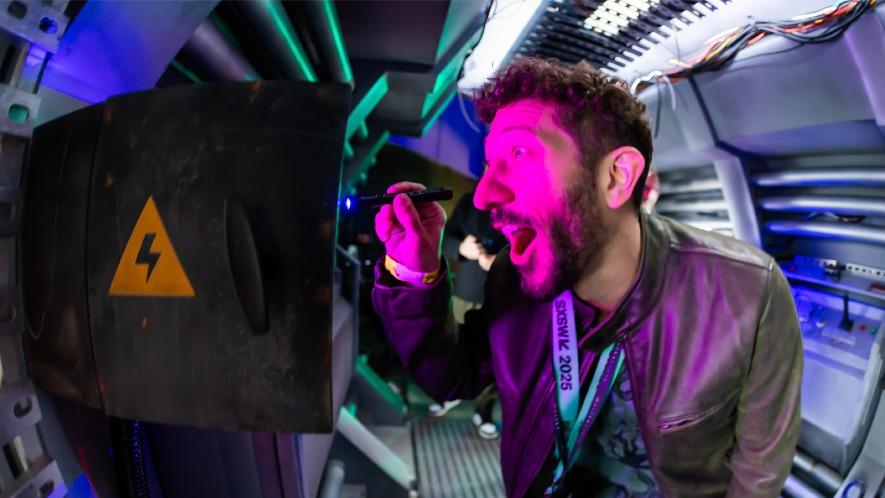
Next in tech 2025: Thriving amid disruption with data, AI and agility
Explore key trends in the tech sector for 2025, including AI, business model reinvention, thriving amid regulatory challenges and evolving market dynamics.
A team of PwC industry specialists was on the ground at SXSW in Austin, attending 100+ sessions alongside visionaries, creators, scientists and leaders. Together with SXSW, we’ve captured the key learnings that matter most so you can harness human ingenuity to help shape what's next for your business, your industry and the world. This SXSW 2025 Key Insights report is your strategy playbook for the eight boldest shifts transforming business, technology and society –– today and tomorrow. Business and technology leaders should use these insights to think bigger, move faster and build smarter.
The eight revolutionary shifts explored at SXSW 2025:
From AI that amplifies human creativity to quantum breakthroughs, immersive brand worlds and healthcare innovations moving at lightspeed, continue reading to discover how technology will supercharge human ingenuity to build the future — and how your organization can be a part of it.
“AI fundamentally changes the nature of human capabilities, even what it is to be human.”
Neil Redding, Featured Session: The Auto-Evolving Business: AI’s Agentic Near Future
AI isn’t just reshaping workflows; it is reshaping what we believe humans are capable of. At SXSW, a new perspective emerged: AI is not here to replace us, but to unlock new dimensions of creativity, problem-solving, and human connection.
AI is no longer an edge case—it’s a defining force in how ideas are developed, decisions are made, and industries evolve. Leaders who wait for perfect clarity will find themselves outpaced by those who act now. The opportunity isn’t just to integrate AI—it’s to reshape what your organization can imagine, build, and become. This is a call to lead: reimagine workflows, empower every team with AI fluency, and invest in creativity and curiosity as core capabilities. The future will favor those who treat AI not as a threat to manage, but as a partner to help redefine what’s possible.
“Quantum computing is no longer a distant future – it is already proving useful today. By 2026, it will surpass classical computing in solving problems that were previously impossible.”
Session: Cracking the ‘Cradle of Life’ Molecule with a Quantum Computer
Quantum computing is set to revolutionize our world – from developing new drugs and materials, to helping bring back lost species. It has gone from something far in the future to something expected to drive meaningful innovation in the near term.
The message from the experts is clear: Quantum computing isn’t a 20-year from now idea— it’s happening now. Quantum computing is a really complicated subject, and it provides the ability to build upon and solve complex problems that are often too time consuming for even the most powerful traditional computers. Companies that invest early will shape the industries of the future, while those that hesitate will be left playing catch-up. The question isn’t whether quantum computing will change your industry—it’s whether you’ll be ready when it does.
“Uncertainty raises risk and slows investment. [Strong economic] policy needs clear, transparent and stable regulatory models.”
Session: Innovations Driving the Future of Energy
The intersection of policy, economics, and innovation has grown increasingly complex and dynamic. At SXSW, the message was clear: regulation will evolve, markets will shift, and industries will be disrupted—but those who move decisively, invest strategically, and shape their own path forward will define what comes next.
Innovation doesn’t happen in isolation—it’s shaped by policy, investment, and economic forces. Public and private partnerships working together to accelerate innovation and help keep markets that invest in the cutting edge. The companies and industries that act now— investing in talent, technology, and trust—will be the ones defining the future.
“Your kid in their bedroom [online] might be encountering more danger than they would out at the park with friends.”
Lauren Greenfield, Session: Gen Z Social Media’s Dark Side - Brand and Advertising
As more of our lives are digital, it drives increased risk that digital experiences have an outsized influence on human behavior in both positive and detrimental ways. With humankind already spending considerable time online, and AI and other innovations poised to create even more compelling digital experiences, the imperative for ethical and thoughtful innovation has never been higher.
As technology becomes more immersive, intelligent, and embedded in daily life, the real risk isn’t just what systems can do—but how they shape what we think, feel, and choose. Protecting users now means protecting attention, autonomy, and agency. Business leaders must prioritize ethical design, transparent AI, and proactive trust-building to make sure innovation advances not just technology—but humanity.
“The things that stand out, the things that are remembered, are always different.”
Melina Palmer, Session: Enough with the “Delving” – Staying Human in the Age of AI
The most memorable brands aren’t built through messaging alone—they’re built through moments and stories that people can feel, remember, and share.
The future belongs to brands that don’t just speak—but invite participation. In a world where audiences expect to be part of the story, the most powerful connections are built through shared experiences, creator collaboration, and storytelling that adapts in real time.
Emerging technologies (like AI and XR) can extend that creative canvas—but it’s imagination, trust, and emotional relevance that drive true impact. The brands that lead tomorrow will be the ones that engage meaningfully today.
“We are not just treating disease—we are reprogramming the human body at the genetic level. This is a tidal wave of innovation, and it’s coming faster than you think.”
Nicole Paulk, Session: Viruses as Medicine: Shaping the Frontier of Gene Therapy
This year’s SXSW sessions showcased groundbreaking advancements in brain science, precision medicine, and AI-driven diagnostics, ushering in a new treatment era for conditions once considered untreatable—those previously thought impossible to treat with medication. Rapid progress in neurodegenerative disease and cancer research is being fueled by AI and stem cell-derived organoids. The benefits from this innovation will extend beyond healthcare—Alzheimer’s alone is projected to cost the U.S. $1 trillion annually by 2050, posing major implications for the workforce and caregivers1. The development of curative treatments in these areas will have a profound impact on all Americans.
AI and emerging technologies are revolutionizing drug discovery, diagnostics, clinical trials, and health data management. Business leaders have a key role in building a more effective and equitable healthcare system. With Americans spending $500 billion annually out-of- pocket on healthcare, Healthcare Consumerism is gaining momentum, shifting power back to patients and caregivers. To thrive in this evolving landscape, companies must drive meaningful change by improving accessibility, enhancing the consumer experience, and expanding direct-to-patient care models.
“Going to space is hard, but collaboration makes it possible—no one company or agency can do it alone, and that’s what makes this new era of exploration so exciting.”
Trina Patterson, Session: Messaging the Moon
Space’s role is going well beyond exploration—it is rapidly becoming a proving ground for groundbreaking innovation across industries. From using microgravity to advance health research (such as aging studies and dementia treatments) to building the infrastructure for off-Earth living, space is playing a crucial role in shaping the future. With AI-enabled discovery, commercial investment, and new partnerships between public and private sectors, the industry is expanding. NASA continues to play a leading role, but new opportunities are emerging for private companies, entrepreneurs, and cross-sector innovators to actively contribute to and benefit from this growing ecosystem, offering strategic advantages for industries beyond aerospace.
The acceleration of AI-powered research, private-sector collaboration, and affordable space access is shifting space from a government-funded mission to a commercial frontier. Companies that integrate space-driven insights, technology, and partnerships into their strategies today will shape the next era of innovation, sustainability, and economic growth. Space is no longer just for astronauts—it’s a business opportunity with limitless potential.
“If we embrace technology, we have the opportunity to completely reshape not just our physical space, but also now, the cognitive one.”
Ian Beacraft, Session: How Not to Screw up an AI Transformation
Artists are unlocking more immersive fan experiences that unlock a new layer of authentic creation and access. These experiences are paving the way for creator and tech partnerships—and the future of fandom in VR and other environments. Fans are also being invited more and more to co-create content and shape the future of entertainment.
The future of entertainment belongs to those who design with their audiences. As fans become collaborators, co-creators, and stakeholders, the companies that thrive will be the ones that build living, participatory ecosystems—where content evolves, engagement is active, and value is shared. Passive consumption is out; immersive, co-created experiences are in. This shift isn’t just transforming how we entertain—it’s redefining how creators, brands, and platforms operate. At SXSW, that momentum was palpable. From hallways to headline sessions, creators stood alongside technologists, marketers, and storytellers, not on the sidelines, but in the mix, helping shape what’s next. For anyone looking to understand or participate in the future of media, community, and commerce, SXSW offers more than access. It offers a blueprint.
1Alzheimer’s Association. 2024 Alzheimer’s Disease Facts and Figures. Alzheimer’s Association, 2024, https://www.alz.org/getmedia/76e51bb6-c003-4d84-8019-e0779d8c4e8d/alzheimers-facts-and-figures.pdf.
2GoodRx Research. The Prescription Drug Gender Divide: Women Spent Over $8.5 Billion More Than Men in 2024. GoodRx, 7 Mar. 2025, https://www.goodrx.com/healthcare-access/research/prescription-drug-gender-gap-women-spend-more

Explore key trends in the tech sector for 2025, including AI, business model reinvention, thriving amid regulatory challenges and evolving market dynamics.

It’s time for a new approach that doesn’t attempt to control the entire customer experience but instead empowers the key roles that influence it.

Quantum computing offers game-changing capabilities. Discover how organizations can prepare, mitigate risks, and unlock its full potential.

Report reveals six trends that will shape how businesses succeed in the coming year. With perspectives from PwC leaders and real-world client examples, this report is your roadmap to turning AI investments into tangible business outcomes.


